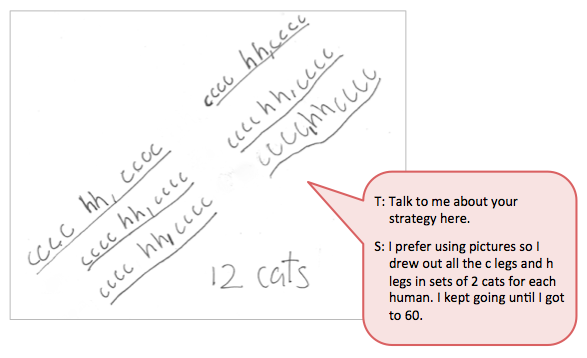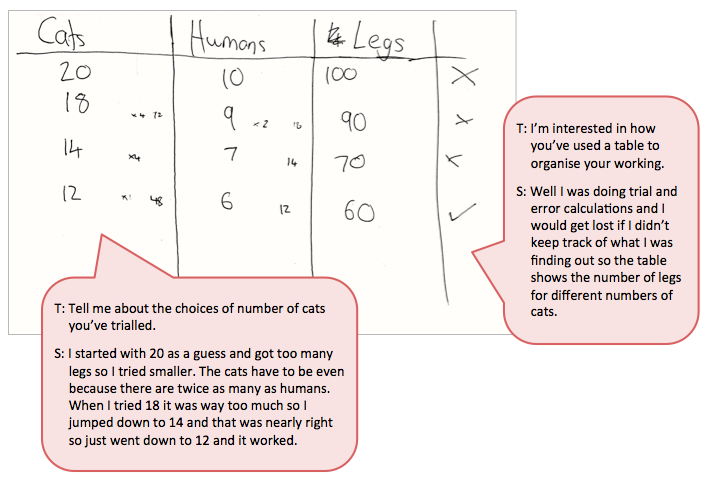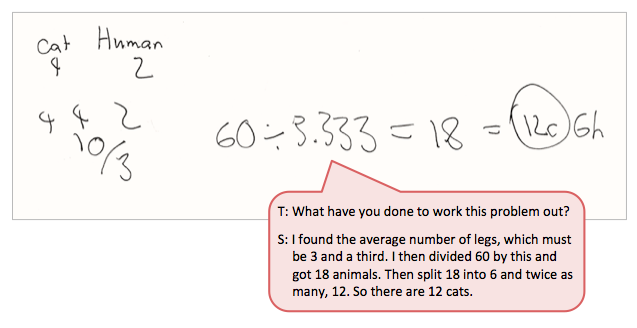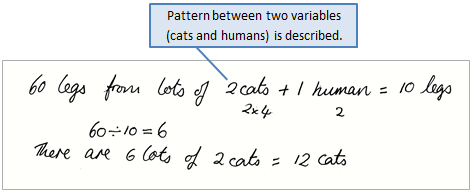The purpose of this activity is to engage students in solving a problem involving the multiplicative strategies that form the basis of early algebraic investigation.
This activity assumes the students have experience in the following areas:
- Expressing relationships between two variables using algebraic equations.
- Graphing ordered pairs on a number plane to represent a relation.
- Using tables to display a relationship between variables and looking for patterns in the table.
- Expressing word problems using expressions and equations.
The problem is sufficiently open ended to allow the students freedom of choice in their approach. It may be scaffolded with guidance that leads to a solution, and/or the students might be given the opportunity to solve the problem independently.
The example responses at the end of the resource give an indication of the kind of response to expect from students who approach the problem in particular ways.


In our household, there are twice as many cats as humans, with sixty legs in total.
How many cats are there to be fed?
The following prompts illustrate how this activity can be structured around the phases of the Mathematics Investigation Cycle.
Make sense
Introduce the problem. Allow students time to read it and discuss in pairs or small groups.
- Do I understand the situation and the words? (Students may need to assume that humans have two legs and cats have four legs. The total of 60 legs is composed of cat legs and human legs.)
- What might be the difficult part of this problem? (Honouring the conditions for total number of creatures, twice as many cats, and total of legs simultaneously.)
- What will my solution look like? (The solution will consist of the number of cats and justification to show the number meets the conditions.)
Plan approach
Discuss ideas about how to solve the problem. Emphasise that, in the planning phase, you want students to say how they would solve the problem, not to actually solve it.
- What maths am I going to need to solve this problem?
- What strategies might be useful? Could I try a simpler problem first?
- Can I represent the problem as a diagram or a table or as equations?
- How will I record my working so I don’t get lost, or miss important patterns?
- How might I work with others on this problem? How will we share our mahi?
- What tools (digital or physical) could help my investigation? (A spreadsheet is very useful for solving problems with variables. Graphic software like Desmos is also helpful.)
Take action
Allow students time to work through their strategy and find a solution to the problem.
- Have I shown my workings in a step-by-step way?
- Is my strategy working or do I need to change direction?
- What patterns do I notice? (Changing one cat for one human decreases the total number of legs by two while keeping the number of creatures constant.)
- How can I use the patterns to solve the problem?
- Is my answer the same as others? Have they used the same strategy?
- Is there another possible answer or way to solve it?
Convince yourself and others
Allow students time to check their answers and then either have them pair share with other groups or ask for volunteers to share their solution with the class.
- What is my solution?
- How would I convince someone else I am correct?
- Can I justify how I got to my answer in a clear way that others can understand?
- Which ideas or tools worked well in my investigation?
- What could I try differently next time?
- What connections can I see to other situations? Would similar strategies work on other problems? How?
- What maths did I learn? What new maths do I need? (Students might learn how to solve problems like this using intersections of graphs.)
Examples of work
Work sample 1
The student represents the problem as a diagram and works with the diagram to find a solution by trial and improvement.
Click on the image to enlarge it. Click again to close. 
Work sample 2
The student creates a table of values for number of cats, number of humans, and total number of legs. They use pattern to find a solution from the table.
Click on the image to enlarge it. Click again to close. 
Work sample 3
The student uses the ‘twice as many cats’ condition to create a total number of legs for 2 cats and 1 human (10 legs). They calculate 60 ÷ 10 = 6 to find the number of 2:1 ratio needed.

